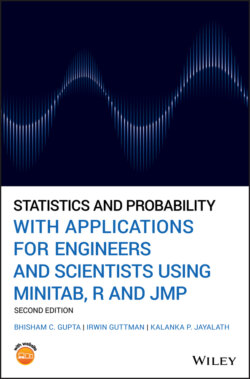Читать книгу Statistics and Probability with Applications for Engineers and Scientists Using MINITAB, R and JMP - Bhisham C. Gupta, Irwin Guttman - Страница 125
3.5 Conditional Probability
ОглавлениеIn some probability problems, we are asked to find the probability that an event F occurs when it is known or given that an event E has occurred. This probability, denoted by and called the conditional probability of F given E, is obtained essentially by letting E be a new sample space, sometimes known as an induced sample space, and then computing the fraction of probability on E that lies on , that is,
(3.5.1)
where, of course, . Similarly
(3.5.2)
where . The conditional probability of , given that E has occurred, using (3.5.1), is
Since we are in the “new” sample space E, we find that (see Figure 3.6.1)
That is, the rule of complementation is preserved in the induced sample space E.
Example 3.5.1 (Concept of conditional probability) The manufacturing department of a company hires technicians who are college graduates as well as technicians who are not college graduates. Under their diversity program, the manager of any given department is careful to hire both male and female technicians. The data in Table 3.5.1 show a classification of all technicians in a selected department by qualification and gender. Suppose that the manager promotes one of the technicians to a supervisory position.
1 If the promoted technician is a woman, then what is the probability that she is a nongraduate?
2 Find the probability that the promoted technician is a nongraduate when it is not known that the promoted technician is a woman.
Solution: Let S be the sample space associated with this problem, and let E and F be the two events defined as follows:
E: the promoted technician is a nongraduate
F: the promoted technician is a woman
In Part (a) we are interested in finding the conditional probability .
Since any of the 100 technicians could be promoted, the sample space S consists of 100 equally likely sample points. The sample points that are favorable to the event E are 65, and those that are favorable to the event F are 44. Also the sample points favorable to both the events E and F are all the women who are nongraduates and equal to 29. To describe this situation, we have
(a) Therefore,
and for part (b), we have that .
Table 3.5.1 Classification of technicians by qualification and gender.
| Graduates | Nongraduates | Total | |
| Male | 20 | 36 | 56 |
| Female | 15 | 29 | 44 |
| Total | 35 | 65 | 100 |
Note that the probability P(E), sometimes known as the absolute probability of E, is different from the conditional probability P(E|F). If the conditional probability P(E|F) is the same as the absolute probability P(E), that is, P(E|F) = P(E), then the two events E and F are said to be independent. In this example, the events E and F are not independent.
Definition 3.5.1 Let S be a sample space, and let E and F be any two events in S. The events E and F are called independent if and only if any one of the following is true:
(3.5.3)
(3.5.4)
(3.5.5)
The conditions in equations (3.5.3)–(3.5.5) are equivalent in the sense that if one is true, then the other two are true. We now have the following theorem, which gives rise to the so‐called multiplication rule.
Theorem 3.5.1 (Rule of multiplication of probabilities) If E and F are events in a sample space S such that , then
(3.5.6)
Equation (3.5.6) provides a two‐step rule for determining the probability of the occurrence of by first determining the probability of E and then multiplying by the conditional probability of F given E.
Example 3.5.2 (Applying probability in testing quality) Two of the light bulbs in a box of six have broken filaments. If the bulbs are tested at random, one at a time, what is the probability that the second defective bulb is found when the third bulb is tested?
Solution: Let E be the event of getting one good and one defective bulb in the first two bulbs tested, and let F be the event of getting a defective bulb on drawing the third bulb. Then, is the event whose probability we are seeking. Hence,
The sample space S in which E lies consists of all possible selections of two bulbs out of six, the number of elements in S being . The event E consists of all selections of one good and one defective bulb out of four good and two defective bulbs, and the number of such selections is . Therefore, . We now compute , the probability that F occurs given that E occurs. If E has occurred, there are three good and one defective bulb left in the box. F is the event of drawing the defective one on the next draw, that is, from a box of four that has three good bulbs and one defective. Thus, . The required probability is
For the case of three events, , the extended form of (3.5.6) is
(3.5.7)
provided that and are both not zero. Formula (3.5.7) extends to any finite number of events . Note that equation (3.5.5) also can be extended to the case of several mutually independent events so that for these n independent events
(3.5.8)
Example 3.5.3 (Rolling a die n times) If a true die is thrown n times, what is the probability of never getting an ace (one‐spot)?
Solution: Let be the event of not getting an ace on the first throw, the event of not getting an ace on the second throw, and so on. Assuming independence of the events and a “true” die, we have . Hence, the required probability from (3.5.8) is
